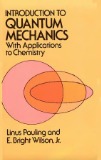| dc.contributor.author | by Linus Pauling and E. Bright Wilson, Jr. | |
| dc.date.accessioned | 2016-02-20T03:13:27Z | |
| dc.date.available | 2016-02-20T03:13:27Z | |
| dc.date.issued | 1935. | |
| dc.identifier.isbn | 0070855579,9780070855571 | |
| dc.identifier.issn | | |
| dc.identifier.uri | http://ir.nmu.org.ua/handle/GenofondUA/19753 | |
| dc.description.abstract | This text applies quantum mechanics to a broad range of chemical and physical problems, covering such subjects as wave functions for the hydrogen atom, perturbation theory, the Pauli exclusion principle, and the structure of simple and complex molecules. Numerous tables and figures. --From publisher's description.
Survey of classical mechanics. Newton's equations of motion in the Lagrangian form ; The equations of motion in the Hamiltonian form ; The emission and absorption of radiation --
The old quantum theory. The origin of the old quantum theory ; The quantization of simple systems ; The hydrogen atom ; The decline of the old quantum theory --
The Schrödinger wave equation with the harmonic oscillator as an example. The Schrödinger wave equation ; The physical interpretation of the wave functions ; The harmonic oscillator in wave mechanics --
The wave equation for a system of point particles in three dimensions. The wave equation for a system of point particles ; The free particle ; The particle in a box ; The three-dimensional harmonic oscillator in Cartesian coordinates ; Curvilinear coordinates ; The three-dimensional harmonic oscillator in cylindrical coordinates --
The hydrogen atom. The solution of the wave equation by the polynomial method and the determination of the energy levels ; Legendre functions and surface harmonics ; The Laguerre polynomials and associated Laguerre functions ; The wave functions for the hydrogen atom --
Perturbation theory. Expansions in series of orthogonal functions ; First-order perturbation theory for a non-degenerate level ; First-order perturbation theory for a degenerate level ; Second-order perturbation theory --
The variation method and other approximate methods --
The spinning electron and the Pauli exclusion principle, with a discussion of the helium atom --
Many-electron atoms. Slater's treatment of complex atoms ; Variation treatments for simple atoms ; The method of the self-consistent field ; Other methods for many-electron atoms --
The rotation and vibration of molecules. The separation of electronic and nuclear motion ; The rotation and vibration of diatomic molecules ; The rotation of polyatomic molecules ; The vibration of polyatomic molecules ; The rotation of molecules in crystals --
Perturbation theory involving the time, the emission and absorption of radiation, and the resonance phenomenon. The treatment of a time-dependent perturbation by the method of variation of constants ; The emission and absorption of radiation ; The resonance phenomenon --
The structure of simple molecules. The hydrogen molecule-ion ; The hydrogen molecule ; The helium molecule-ion He₂⁺ and the interaction of two normal helium atoms ; The one-electron bond, the electron-pair bond, and the three-electron bond --
The structure of complex molecules. Slater's treatment of complex molecules --
Miscellaneous applications of quantum mechanics. Van der Waals forces ; The symmetry properties of molecular wave functions ; Statistical quantum mechanics, systems in thermodynamic equilibrium ; The energy of activation of chemical reactions --
General theory of quantum mechanics. Matrix mechanics ; The properties of angular momentum ; The uncertainty principle ; Transformation theory --
Appendices. Values of physical constants ; Proof that the orbit of a particle moving in a central field lies in a plane ; Proof of orthogonality of wave functions corresponding to different energy levels ; Orthogonal curvilinear coordinate systems ; The evaluation of the mutual electrostatic energy of two spherically symmetrical distributions of electricity with exponential density functions ; Normalization of the associated Legendre functions ; Normalization of the associated Laguerre functions ; The Greek alphabet. | |
| dc.language.iso | English | |
| dc.publisher | McGraw-Hill Book Co. | |
| dc.subject | Химия | |
| dc.subject | Chemistry | |
| dc.subject.ddc | | |
| dc.subject.lcc | | |
| dc.title | Introduction to quantum mechanics : with applications to chemistry | |
| dc.type | other | |
| dc.identifier.aich | G5ZJR7ZW6YHQ3K4CSUHTVN5M7UFA67IL | |
| dc.identifier.crc32 | 5FF6CA3E | |
| dc.identifier.doi | | |
| dc.identifier.edonkey | A58440C9CCA8D64899F48CC8E242FCCA | |
| dc.identifier.googlebookid | | |
| dc.identifier.openlibraryid | | |
| dc.identifier.udk | | |
| dc.identifier.bbk | | |
| dc.identifier.libgenid | 1281828 | |
| dc.identifier.md5 | a274c0be7d8fc81141913b61594d1f71 | |
| dc.identifier.sha1 | GIX3ICC5FFRDBB4MHOC5H7XBJNCER74O | |
| dc.identifier.tth | F2NIV6SQZQVBIIDBI4KN7ZCV3F25IJEZMBPT6TI | |

